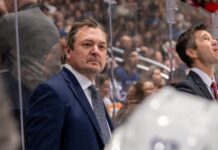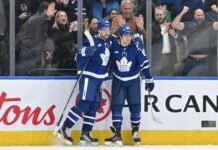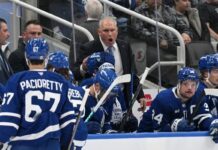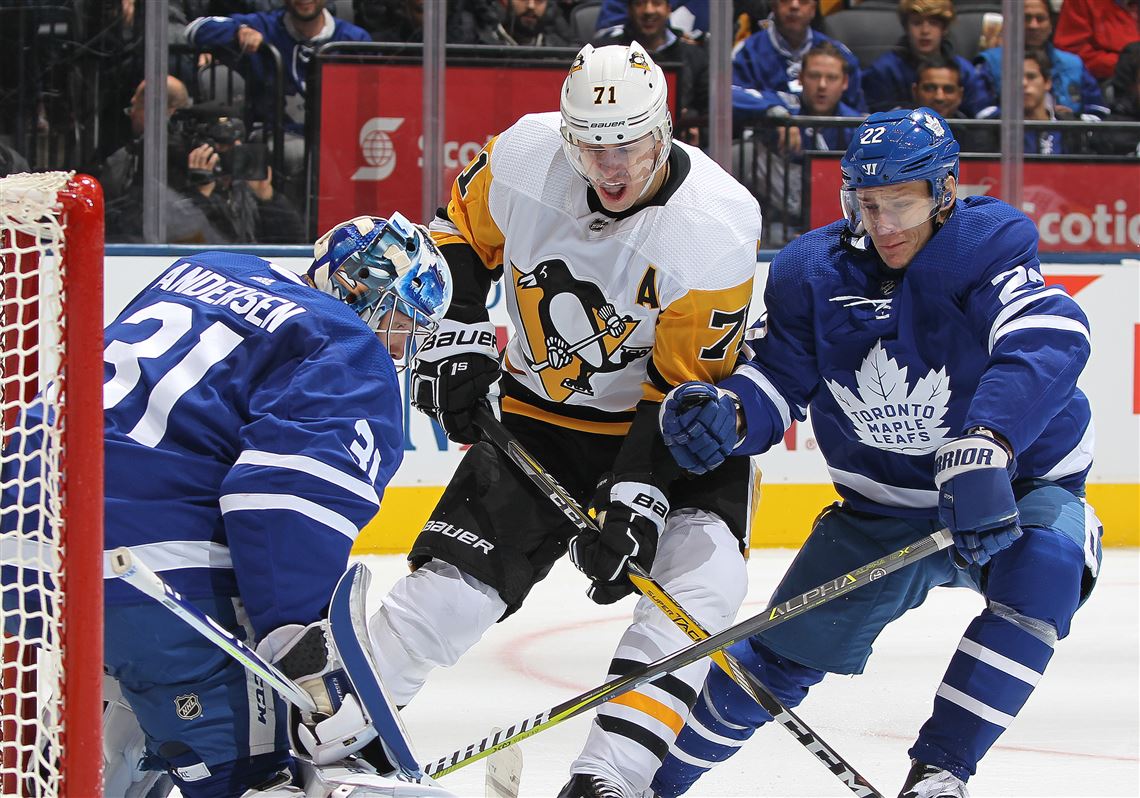For the second straight season, the Toronto Maple Leafs got off to a 6–1–0 start, setting the league on fire by overpowering the opposition offensively.
While the last two games – getting shut out against Pittsburgh and not scoring on St. Louis for the following two periods before losing that game, too – were a sobering experience, in the bigger nine-game picture, there are some concerning signs that will need to be addressed.
The Leafs are currently fourth in the league in goals for and second in power play percentage. By the raw totals, they also have the most even-strength goals in the league. Generally speaking, they’ve lived up to their offensive hype so far despite the ongoing William Nylander holdout.
However, at 5v5, they are also only plus-one in goal differential. Last season, the only playoff teams that got outscored at 5v5 were Pittsburgh, San Jose, and New Jersey. So far this season, the Leafs have overall given up the 11th most goals per game. Shots on goal-wise, they have a negligible difference of 30.7 shots for per game and 30.9 against. Their team corsi is slightly above water at 50.21%; their fenwick (which does not include blocked shots) is 49.04%, and their scoring chance percentage is 48.03% according to NaturalStatTrick.com.
Those are not exactly dominant numbers against what has largely been a mediocre set of opponents so far – only three of the nine teams they’ve played made the playoffs last season.
So what’s happening here?
First off, they still have a good record and a large part of that is special teams – their PP is second in efficiency and their PK is seventh. That’s pretty well always going to be a winning recipe. Not to mention Auston Matthews is leading the league in scoring and Morgan Rielly leads all defensemen in scoring. Some players have started white hot.
On the other end, their bottom six scoring is basically non-existent. They’ve had seven forwards in that grouping – Nazem Kadri, Connor Brown, Par Lindholm, Josh Leivo, Frederik Gauthier, Andreas Johnsson, and Tyler Ennis. Only Brown, Lindholm and Leivo have goals (one each) in that group; Brown’s goal was an empty-netter, while Leivo’s was on the PP.
That helps to explain the goal differential at 5v5. It’s going to be hard to outscore teams there if half their forward group is essentially not producing at evens. Some of that will correct, but they also have to seriously look at this group and ask themselves if it’s good enough.
And then, of course, their defense struggles. In particular, the Jake Gardiner – Nikita Zaitsev pairing is currently carrying only 44% of the shot attempt share – they can’t move the puck up the ice together cleanly and there’s clearly no chemistry between the two (although they’ve only been outscored by two).
The other two pairings have been fine — Morgan Rielly – Ron Hainsey is humming along over 53 CF%, while Travis Dermott and Igor Ozhiganov are at 60 CF% — but that’s mitigated when the Gardiner and Zaitsev pairing struggles to control the puck while playing the most of anyone on the team (Zaitsev is first in average time on ice, Gardiner is third).
Quietly, Patrick Marleau and Auston Matthews are controlling 45.7% of shot attempts together and are even in goals, while the Tavares line as a whole is just slightly underwater at ~49.6 CF%. At least both of those lines can score, though (John Tavares and Mitch Marner have outscored opponents 10 – 4 so far).
All in all, their record and play so far make sense. At 5v5, their top lines don’t dominate and their top pairing (time on ice wise) gets outplayed, but their special teams are elite.
Notes
– Don’t look now, but through six games, Frederik Gauthier has a 52.1 CF%, with 58.8% of his non-neutral zone faceoff starts coming in the defensive zone. All of his regular linemates – Josh Leivo, Tyler Ennis and Andreas Johnsson – are above water playing alongside him on the fourth line. His first game against Dallas is the only one where he’s played over 10 minutes, but his line has strung together some strong games, relatively speaking.
While Gauthier is not a threat with the puck, one thing he can do is use his reach to poke pucks off defenders and extend offensive zone time. He’s good at creating turnovers; against LA, a few times he was able to extend his stick out while behind a player and deflect passes because it catches opponents off guard. In general, he’s taking shifts and doing an okay job.
Surprisingly, the thing he was supposed to be known for, faceoffs, has been below par at 48.6%.
– There was another highlight reel goal last week that was caused by Zach Hyman on his strong side. Last season, he had the beauty of goal in the playoffs against Boston and the one against the Rangers that really stood out. He didn’t score the goal against the Kings, but he made the play that created it. He’s shown he’s more than capable of making skilled, power move plays on his strong side (but not his off-side), although he’s never started a single game as a right winger while with the Leafs.
– An ice time number that’s been surprising so far – Zach Hyman averaging only 16:39 per night so far, fifth among forwards. Often times last season, he was leading the forwards in ice time by the end of games. Through nine games, Hyman doesn’t have a goal and has only 11 shots on net, but his forechecking and hustle have created a ton of scoring opportunities and zone time for teammates.
– Against the Penguins, Auston Matthews went head-to-head against Crosby and Tavares went head-to-head against Malkin. Babcock implied that Kadri would be going back to this role due to Lindholm getting adjusted along the wing, which would make Babcock more comfortable deploying that line in a more head-to-head role. Matthews had only 33% of the shot share against Crosby, but most people could clearly see he was handily beat in that matchup as Crosby dominated the puck and play. The Leafs have barely played any good teams, as noted above, so it’s been tough to get a feel for it, but the first look wasn’t pretty.
– Not much use going back into the NHL history of holdouts (Ken Dryden, Eric Lindros, Pavel Bure, etc.), but the one that really stands out in comparison to William Nylander’s: Ryan O’Reilly. The only reason he ended up under contract was that he signed an offer sheet. In the lockout season, he signed nearly two months in and played only 29 games. Eventually, he ended up getting traded. Approaching Halloween without a deal, it’s hard to see a long-term deal coming together at this point.
– That was a season-high 20:12 for Travis Dermott against the LA Kings. The game was not in doubt in the second half of the third period, but against good teams in the following two games, he played 18:42 and 17:17. Those are not leap-off-the-page minutes, and he struggled against St. Louis, but he’s slowly moving his way up the ice time ladder and could be a top-four regular in the second half of the season.
– One thing to look out for when watching opponent’s PK against the Leafs – how they are taking away cross-ice plays and high tip plays. The Leafs pick apart the bad teams, but the good teams really focus on pressuring Marner and Matthews, not allowing them clean looks. They are daring Rielly to shoot. The Leafs have also brought back the drop pass breakout, which was something they really got away from last season (in part because JVR was quite good at taking passes at the far blue line and gaining the zone).
Quotes
“And yet, you look at all of the teams, and the Washington Capitals were the biggest team in the NHL last year. There is a reason you win, too, right? Especially at playoff time. Let’s not get carried away. We need big men.”
– Mike Babcock in preseason
I’ve been thinking about this quote a lot as teams start to jam the Leafs up in the neutral zone and check them tighter (Pittsburgh and St. Louis being prime examples). I know dumping it in and forechecking is considered ancient, but you need some element of that to your game when teams jam you up at the blue line. The Leafs really struggle to forecheck, create turnovers, and drive the dirty areas — which is why Zach Hyman stands out so much. Beyond him, though, they don’t have many guys consistently able to get in on a forecheck and create turnovers. Teams are basically daring them to try right now. Through two periods at home against the Blues, the Leafs had eight shots on net.
“You look at the talent we have and the cap space, and it’s going to be tough. We will see what happens. The good way to approach it is you put it all aside, just play hockey. We have a good team here, we’re in a good spot to succeed and I’ll just focus on winning hockey games. If the Leafs want to do something, we still start talking, but until then, we’ll just keep playing.”
– Jake Gardiner on his potential contract negotiations with the Leafs
It’s just tough to see the numbers fitting based on how much he should expect to make (at least $6 million) and the other contracts the Leafs need to get done. We’ll see what happens, but it feels like another JVR situation. Gardiner has seven points in nine games so far, by the way.
“We got to do a better job coming out of our own end & being a little bit cleaner allowing us to use our speed & get on the forecheck … they did a good job of slowing it down and protecting the middle of the ice.”
– John Tavares breaking down what happened against St. Louis
Sounds a lot like last season. They need to do a better job of actually breaking out instead of just blowing the zone, and they need to diversify their forward group a bit. Good teams can contain them if they don’t take penalties.
5 Things I Think I’d Do
1. At some point (soon), I think you have to consider breaking up the Hyman – Tavares – Marner line just to try something new. We’re an eighth into the season, basically; another year of the same lines all season before getting to the playoffs and realizing things need to be shaken up for the first time doesn’t make much sense. Plus, the line has been good and dynamic offensively, but they don’t tilt the ice and dominate opponents; they are skilled and bury their chances.
2. I think Tyler Ennis acquitted himself well on the fourth line, but I’d give Andreas Johnsson an extended run. They have to see what they have there and Ennis is pretty much on a one-and-done cheap veteran contract unless something drastically changes in his play (and if it did, he’d price himself out of Toronto anyway). Johnsson has the potential to move up the lineup and possibly be a mainstay for years to come.
3. I think Nazem Kadri will eventually get a power play goal, but it would be nice to either move him up with better linemates at points or give him better linemates throughout the game to get him going. He has been playing some good hockey, but getting him rolling would really help the team’s overall 5v5 play.
4. As someone who pushed to see more of him the last few seasons, I think it’s only fair to say Josh Leivo really hasn’t done enough to this point to lock in a roster spot. He hasn’t been bad, but he definitely has not forced his way into being a regular with his play, which is a little disappointing. I also don’t think he can play his off-wing. While putting him on the left wing alongside Kadri sounded nice in theory, it was really a disservice to him.
5. I think playing Winnipeg twice in a row is a great test. I wish the NHL did more back-to-back hockey — it’s always great for creating animosity on the ice and entertainment for the fans.




![Craig Berube on the Leafs’ ugly win over the Islanders: “The [fourth line] provided the energy we needed, because it was low” Craig Berube, Toronto Maple Leafs head coach](https://mapleleafshotstove.com/wp-content/uploads/2024/11/craig-berube-pg-vgk-218x150.jpg)























![Craig Berube on the Leafs’ ugly win over the Islanders: “The [fourth line] provided the energy we needed, because it was low” Craig Berube, Toronto Maple Leafs head coach](https://mapleleafshotstove.com/wp-content/uploads/2024/11/craig-berube-pg-vgk-100x70.jpg)




